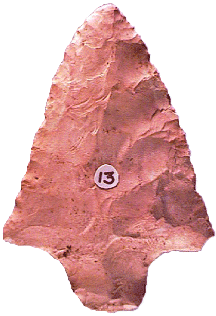
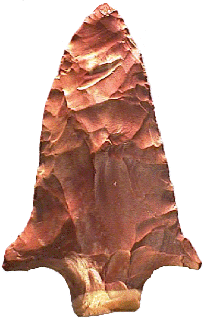


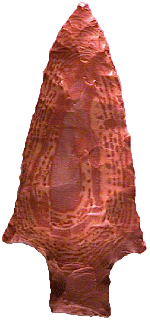
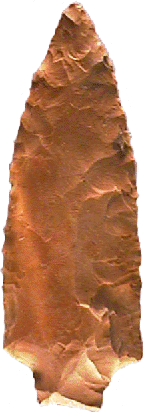
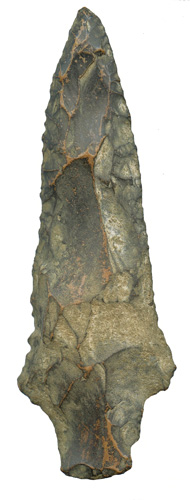
Point Type: PICKWICK
Also See: Abbey,
Elora, Etley, Flint River, Ledbetter, Little
Bear Creek, Maples, Mulberry Creek, Shoals Creek
Location: Southeastern United States
Associated Dates:
6000 - 3500 B.P. - Middle to Late Archaic
Morphology: Stemmed
General Description: The Pickwick type is a medium to large sized expanded shoulder, flaring barbed, and contracting to expanding stem blade. The blade edges are recurvate, and many examples show fine secondary pressure flaking with serrations. Some specimens show unifacial bevels if they have been resharpened and reworked. The shoulders tend to be horizontal and about one-half of the specimens that you will encounter will have asymmetrical shoulders. The distal end is usually acute. The basal edge varies from straight to convex or slightly rounded and the basal area is rarely ground. Many larger examples of the type have wide blades with excurvate blade edges and slight recurvature. Resharpening of the blade was accomplished by both percussion thinning and pressure edge retouch with final stages of the blade ending up as drills.
The Pickwick type is usually found in the shell mound areas of the Tennessee River in the states of Tennessee and Alabama. The larger examples of the Pickwick resemble the Etley point which is approximately the same age.
The size of the Pickwick point ranges from 64 mm to 117 mm in length, shoulder width being between 39 and 55 mm. Typical mid-blade thickness is between 6 and 13 mm and mid shoulder thickness between 9 and 12 mm. Stem width ranges between 15 mm and 24 mm and stem length ranges between 9 mm and 22 mm. The point was named by David L. DeJarnette in 1962 for examples which were recovered from sites in the Pickwick Basin and Lake of the Tennessee River Valley, northern Alabama.
About the Point Above (Top Left): The large Pickwick blade pictured at the top left of this page, was found near the town of Clifton in Wayne County, Tennessee. The point is made from light pinkish colored chert that may have been heat treated. The edges are finely serrated but are rather dull to the touch and show some amount of abrasion. Overall, the point measures 82 mm in length, is 54 mm wide across the barbs (note that one barb is chipped), is 47 mm wide at mid blade, and is 8 mm thick in mid blade and 10 mm at the shoulders. The stem is 13 mm long and 20 mm wide. The stem thickness is 6.5 mm. Due to its wide blade, this specimen is probably a near pristine blade and has not undergone resharpening and size reduction. Catalog Number 13-25-D
About the Point Above (Top Right): The large reddish/maroon jasper Pickwick blade pictured at the top right of this page, was found in Franklin County, Missouri. The point is made from a glossy maroon jasper with two cream colored rind bands at the tip of the stem. This point sports expanded shoulder barbs. Overall, the point measures 83 mm in length, is 50 mm wide across the barbs and is 11 mm thick in mid blade just above the shoulders. The stem is 19 mm long and 19 mm wide. The stem thickness is 7 mm. Catalog Number 209-178-J
About the Point Above (Bottom Left): The large colorful heat treated Buffalo River chert Pickwick blade pictured at the bottom left of this page, was found in Benton County, Tennessee. The point is made from a satin maroon, red, pink and cream-pinkish colored Buffalo River chert that has been heat treated. The colorful design in circular in nature. The blade edges are not serrated. Overall, the point measures 83 mm in length, is 38 mm wide across the barbs and is 10 mm thick in mid blade just above the shoulders. The stem is 21 mm long and 20 mm wide. The stem thickness is 5 mm. Catalog Number 146-166-D
About the Point Above
(Bottom Center):
The large tan chert Pickwick blade pictured at the top of the page
at the bottom center was found in McNairy County, Tennessee. The
point is made from a satin tan colored chert. The blade edges are
not serrated. Overall, the point measures 107 mm in length, is 34
mm wide across the barbs and is 11 mm thick in mid blade just
above the shoulders. The stem is 13 mm long and 17 mm wide. The
stem thickness is 6 mm and the basal edge is slightly concave. Catalog Number 118-46-D
About the Point Above (Bottom Right): The large dark creek stained and polished Pickwick blade
pictured at the top of the page at the bottom right was found in
the Tennessee River by a diver and was formerly in the Jeremy Capley
collection. The point is made from a water smoothed reddish
tan colored chert. The blade edges are faintly serrated. Overall, the
point measures 92 mm in length, is 32 mm wide across the barbs and is 13 mm
thick in mid blade just above the shoulders however the majority of the blade
area is 8.4 mm thick. The stem is 17 mm long and 17 mm wide. There is a
corner of the stem that was chipped in ancient times as the chip is
polished and stained. The stem thickness is 6.8 mm and the basal edge is
slightly convex. Catalog
Number 230-49-AB
References: Baker, Cambron & Hulse, Justice (1), Overstreet, Perino(1), Puckett (1), Sowell & Nowak
© Copyright 1997 - 2009 LITHICS-Net WWW.LITHICSNET.COM
Use your Browser's BACK Button to return to the LITHICS-Net Index.